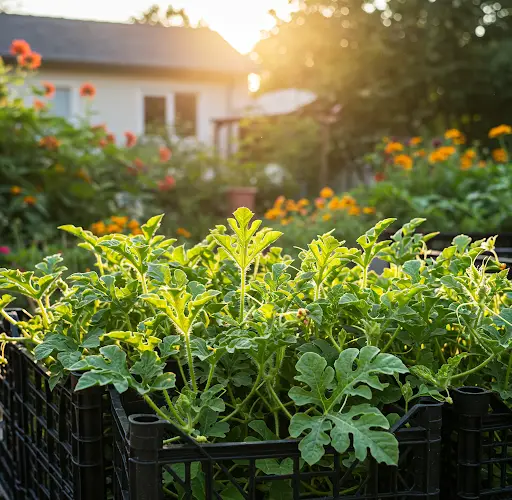How to Grow Watermelon at Home – An Easy Guide for Beginners
Watermelon is the ultimate summer fruit—refreshing, juicy, and loved by all ages. While most people assume that growing watermelons requires a large farm or sprawling backyard, the truth is, with the right approach, you can successfully grow watermelons at home—even in small spaces.
Whether you’re working with a garden, balcony, or even containers, watermelon cultivation is easier than you think. With a little attention and patience, you’ll be enjoying homegrown, sweet watermelons right from your doorstep.
Why Grow Watermelons at Home?
Growing your own watermelon comes with many benefits. It’s cost-effective, rewarding, and gives you full control over how your fruit is grown—free from chemicals or synthetic additives. Plus, the satisfaction of harvesting your own juicy watermelon is unmatched.
With compact varieties available today, you don’t need a large yard. Dwarf and bush types are perfect for home gardens and containers, making watermelon cultivation accessible for beginners and urban gardeners alike.
Step 1: Choose the Right Watermelon Variety
Selecting the right variety is key, especially if you have limited space. Here are a few beginner-friendly and space-saving types:
-
Sugar Baby: A compact variety producing 6–10 pound fruits.
-
Bush Jubilee: Perfect for containers or raised beds.
-
Golden Midget: A small, fast-growing watermelon with yellow rind.
-
Mini Love: Sweet, personal-sized fruit ideal for patios.
These smaller cultivars mature faster and need less room to sprawl than traditional varieties.
Step 2: Pick a Sunny Location
Watermelons love the sun—at least 6–8 hours of direct sunlight daily is essential. Choose a spot in your yard, balcony, or terrace that gets good sun exposure throughout the day. For containers, make sure they can be moved if needed to follow the sun.
Step 3: Prepare the Soil or Container
In the ground:
-
Loosen the soil to a depth of at least 12 inches.
-
Mix in compost or well-rotted manure to enrich it.
-
Watermelons prefer slightly sandy, well-draining soil with a pH between 6.0 and 6.8.
In containers:
-
Use a pot that’s at least 18 inches deep and wide (larger is better).
-
Fill with a well-draining mix of potting soil and compost.
-
Ensure the pot has good drainage holes.
Step 4: Planting Seeds or Seedlings
-
From seed: Sow seeds directly into the soil once temperatures consistently stay above 70°F (21°C). Plant 2–3 seeds per hole about 1 inch deep.
-
From seedlings: Transplant young watermelon plants when they have 2–3 true leaves.
If planting in the ground, space mounds or rows 2–3 feet apart to give the vines room to spread. In containers, plant one seedling per pot.
Step 5: Watering and Feeding
Watermelons need plenty of water, especially during early growth and fruiting. Keep the soil consistently moist, but not soggy. Deep watering encourages strong root growth.
Once fruits begin to form, reduce watering slightly to avoid waterlogged soil and encourage sweeter melons.
Feed with a balanced organic fertilizer every 2–3 weeks. Once flowers appear, switch to a low-nitrogen fertilizer to support fruit development over leaf growth.
Step 6: Pollination
Watermelon plants have male and female flowers. Bees and other pollinators usually take care of this naturally, but if you’re growing indoors or in an area with few pollinators, you can hand-pollinate. Simply use a soft brush or cotton swab to transfer pollen from the male to the female flower (the one with a tiny fruit at its base).
Step 7: Supporting the Vines (Optional)
If space is tight, watermelon vines can be trained to grow vertically on a trellis. Use soft ties to support the vines as they climb. For heavy fruits, create slings with cloth or netting to cradle the melons and prevent them from falling.
Step 8: Harvesting Your Watermelon
Most watermelon varieties mature in 70 to 90 days. Here are some signs your watermelon is ready:
-
The curly tendril nearest the fruit turns brown and dries up.
-
The underside of the fruit (resting on the ground) turns yellow.
-
The rind becomes dull and resists scratching with your fingernail.
Use a sharp knife to cut the fruit from the vine, leaving a short stem attached.
Final Thoughts
Growing watermelon at home is easier than you might expect and incredibly rewarding. Whether you have a backyard garden, raised bed, or just a large container on a balcony, you can enjoy fresh, sweet melons with just a little care. It’s a fun project for the whole family and a delicious way to make the most of your space.
With the right variety, sunlight, and consistent care, your homegrown watermelon can be the highlight of your summer. Don’t let a lack of space stop you — grab a pot, plant a seed, and start your watermelon-growing journey today.



